

Discover Maha Kumbh, Discover India, Discover Yourself
The Maha Kumbh Mela (the festival of the sacred pitcher) is anchored in Hindu mythology. It is the world’s largest public gathering and collective act of faith. This congregation, primarily, includes Ascetics, Saints, Sadhus, Sadhvis, Kalpvasis and Pilgrims from all walks of life.
Kumbh Mela, in Hinduism, is a religious pilgrimage that is celebrated four times over a course of 12 years. The geographical location of Kumbh Mela spans over four locations in India and the Mela site keeps rotating between one of the four pilgrimages on four sacred rivers as listed below:
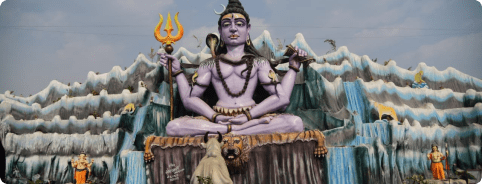
Untruth leads us to Truth, Darkness leads us to Light, Death leads us to Immortality
Each site’s celebration is based on a distinct set of astrological positions of the Sun, the Moon, and the Jupiter. The celebrations occur at the exact moment when these positions are fully occupied, as it is considered to be the holiest time in Hinduism. The Kumbh Mela is an event that intrinsically encapsulates the science of astronomy, astrology, spirituality, ritualistic traditions, and socio-cultural customs and practices, making it extremely rich in knowledge.
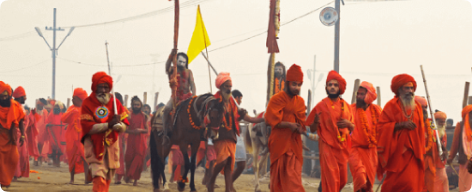
Pilgrims to the Kumbh Mela come from all sections of the religion ranging from Sadhus (saints) and Naga Sadhus who practice ‘sadhana’ and keenly follow a strict path of spiritual discipline, to Hermits who leave their seclusion and come to visit the civilization only during the Kumbh Mela, to seekers of spirituality, and to common people practicing Hinduism.
During the Kumbh Mela, a number of ceremonies take place; the traditional procession of Akharas called ‘Peshwai’ on elephant backs, horses and chariots, the shining swords and rituals of Naga Sadhus during ‘Shahi Snaan’, and many other cultural activities that attract millions of pilgrims to attend the Kumbh Mela.
The Maha Kumbh Mela, a sacred congregation that unfolds every twelve years, is more than a spectacular gathering of millions—it is a spiritual odyssey that delves into the very essence of human existence. Rooted in ancient Hindu mythology, the Maha Kumbh Mela holds a profound inner meaning, serving as a symbolic journey of self-realization, purification, and the eternal quest for spiritual enlightenment.
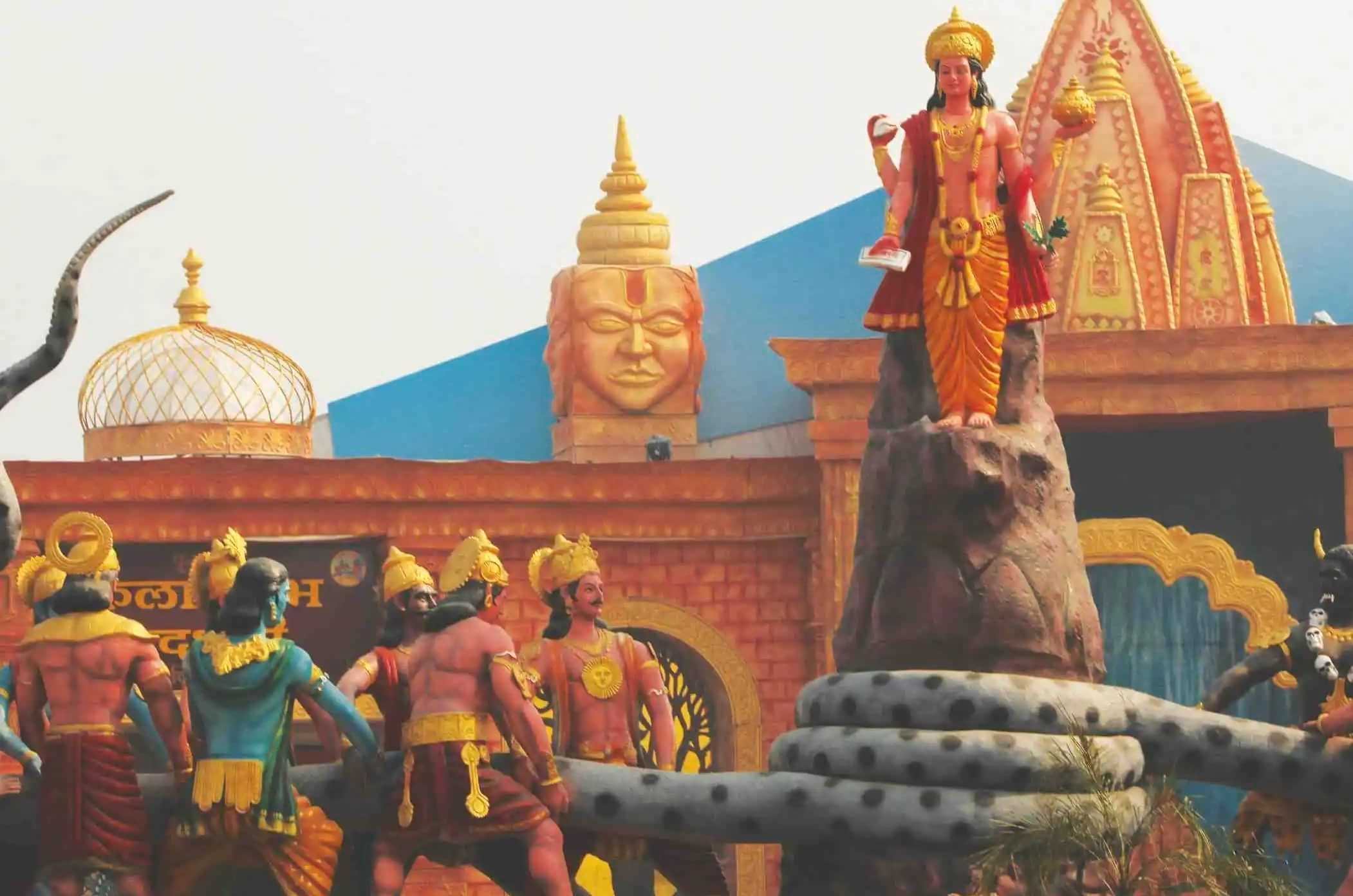
The Symbolism of the Kumbh:
At the heart of the Maha Kumbh Mela lies a symbol steeped in cosmic significance—the "Kumbh" or sacred pot. This vessel, laden with symbolism, transcends its physical form to embody the human body and the quest for spiritual awakening. According to Hindu mythology, the Kumbh symbolizes the celestial pot that emerged during the churning of the cosmic ocean, containing the divine nectar known as "amrita."
Metaphorically, the Maha Kumbh represents the human form, and the nectar within symbolizes the spiritual essence intrinsic to every individual. The pilgrimage to the Maha Kumbh Mela is, therefore, more than a physical journey; it is a symbolic exploration of the self, a recognition of the sacredness inherent in every being.
The Sacred Dip: A Ritual of Purification and Renewal
Central to the Kumbh Mela experience is the ritualistic act of taking a holy dip in the sacred rivers, notably the Ganges, Yamuna, and Saraswati. This act is more than a tradition—it is a spiritual purification, a symbolic cleansing of the body and soul. Pilgrims believe that immersing themselves in these sacred waters not only washes away physical impurities but purifies the mind and renews the spiritual connection with the divine.
The sacred dip is a testament to the transformative power of water—a universal symbol of purity and life. In the immersion, pilgrims seek not just physical cleansing but a profound renewal of the spirit, a rekindling of the divine spark within. The flowing rivers, carrying the weight of centuries of tradition and spiritual significance, become a conduit for seekers to reconnect with their spiritual essence.
Unity in Diversity: A Confluence of Souls
The Kumbh Mela stands as a unique tapestry where threads of diverse cultures, languages, and traditions seamlessly intertwine. It is a testament to the principle of unity in diversity. Pilgrims, irrespective of their background, come together in a celebration of shared spirituality, fostering a sense of brotherhood that transcends societal boundaries.
In a world marked by divisions, the Kumbh Mela serves as a living embodiment of the idea that, beyond our differences, there exists a common thread that binds humanity—a thread woven with the fabric of spiritual seeking. It is a confluence of souls, a gathering where the collective energy of millions resonates with the universal quest for truth and enlightenment.
Cultural Extravaganza: Beyond Rituals and Rhythms
The Kumbh Mela is not only a religious congregation but also a vibrant cultural extravaganza. As pilgrims immerse themselves in rituals and prayers, the air becomes charged with the melody of traditional music, the vibrant hues of cultural performances, and the rhythm of sacred dances. The event becomes a living canvas that showcases the rich tapestry of India's cultural heritage.
Traditional music, often infused with devotional lyrics, becomes a medium for spiritual expression. Artisans from different corners of the country display their crafts, and the Maha Kumbh Mela becomes a melting pot where cultural exchange flourishes. It is an opportunity for pilgrims to not only engage in religious practices but also to witness and participate in the living culture that defines the soul of the nation.
Global Pilgrimage: A Spiritual Harmony Across Borders
In an era of globalization, the Maha Kumbh Mela has evolved into a global pilgrimage. Pilgrims and spiritual seekers from around the world make the journey to the sacred grounds, transcending geographical and cultural boundaries. The Maha Kumbh becomes a meeting point for diverse perspectives, creating an environment conducive to the exchange of ideas and the promotion of global spiritual harmony.
The global participation in the Maha Kumbh Mela underscores its universal appeal. It is a recognition that, despite the diversity of paths, there exists a shared yearning for the transcendent, a common thread that binds individuals on their respective spiritual journeys. The convergence of people from different nations adds a unique flavor to the event, turning it into a global celebration of spirituality.
The Inner Journey: A Pilgrimage of the Soul
As we delve into the profound inner meaning of the Maha Kumbh, it becomes evident that this gathering is not just a congregation—it is an inner journey. It is an exploration of the self, a purification of the soul, and a celebration of our shared humanity. The Kumbh Mela goes beyond the physical rituals and ceremonies; it is an inner pilgrimage where individuals, amidst the vastness of the congregation, seek a personal connection with the divine.
In the convergence of millions, may we find not just a collective of bodies but a symphony of spirits resonating with the eternal quest for truth and enlightenment. The Maha Kumbh Mela is an embodiment of the timeless pursuit of the sacred, a journey that transcends the boundaries of time and space. Welcome to the spiritual tapestry of Maha Kumbh Mela 2025—a pilgrimage of the soul that beckons to all who seek the divine within.
In the sacred tapestry of the Maha Kumbh Mela, where millions congregate to partake in a spiritual spectacle, there exists a profound yet lesser-known facet—Kalpavas. This spiritual sojourn within the vast expanse of the Maha Kumbh Mela holds a unique significance, offering seekers a chance to delve deeper into the realms of devotion, austerity, and the pursuit of spiritual awakening. As we unravel the layers of Kalpavas, we discover a journey that transcends the ordinary, inviting pilgrims to immerse themselves in a celestial realm of introspection and divine connection.
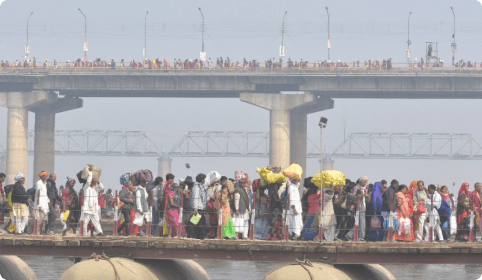
Kalpavas: The Sacred Retreat Within Maha Kumbh Mela
The term "Kalpavas" derives its roots from Sanskrit, where "Kalpa" signifies a cosmic aeon, and "Vas" translates to dwelling or residence. In the context of the Maha Kumbh Mela, Kalpavas represents a sacred retreat, a period of intense spiritual discipline, and a devoted dwelling in the pursuit of higher consciousness. It is a unique opportunity for pilgrims to engage in practices that transcend the ordinary routines of daily life, fostering a deepened connection with the divine.
The tradition of Kalpavas finds its roots in ancient Hindu scriptures, where saints and ascetics embarked on prolonged periods of austere living to attain spiritual prowess. In the context of the Maha Kumbh Mela, Kalpavas unfolds as a dedicated retreat within the larger pilgrimage, providing an immersive experience for those seeking profound spiritual transformation.
The Rituals of Kalpavas:
Kalpavas is not merely a physical retreat; it is a commitment to a set of rigorous rituals and disciplines that pave the way for spiritual elevation. Those participating in Kalpavas dedicate themselves to a life of simplicity, austerity, and devout practices, reflecting the essence of traditional asceticism.
The Significance of Kalpavas:
Challenges and Rewards of Kalpavas:
The Maha Kumbh Mela, a timeless tapestry of faith and fervor, unfolds like a sacred epic, weaving together the threads of history, spirituality, and cultural heritage. This grand pilgrimage, held cyclically at four sacred riverbanks in India—Prayagraj (Allahabad) at the confluence of the Ganges, Yamuna, and Saraswati; Haridwar along the Ganges; Nashik on the Godavari; and Ujjain on the Shipra—is not merely a contemporary spectacle but a tradition steeped in profound historical significance. As we embark on a journey through time, we unravel the layers of history that have shaped the sanctity and prominence of the Kumbh Mela.
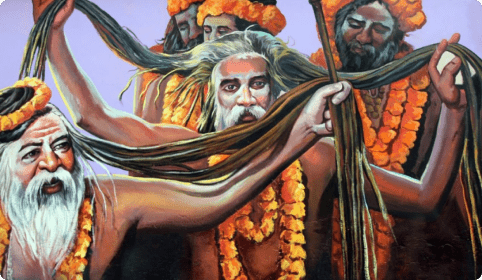
Ancient Roots: Tracing the Origins of Maha Kumbh Mela
The roots of the Maha Kumbh Mela can be traced back to ancient Hindu scriptures and mythological narratives. The earliest references to a similar pilgrimage are found in the Rigveda, one of the oldest sacred texts of Hinduism. The Rigveda speaks of a divine event called the "Sagar Manthan" or churning of the cosmic ocean, which is considered the genesis of the Maha Kumbh Mela.
Legend has it that during this cosmic churning, a pot (Kumbh) containing the elixir of immortality (amrita) emerged. The celestial struggle for possession of this divine nectar ensued, leading to a celestial battle that spanned twelve divine days, equivalent to twelve human years. Drops of the nectar fell at four locations on Earth, marking the sites where the Kumbh Mela is celebrated today.
First Historical References: Maurya and Gupta Periods
The Kumbh Mela finds its first historical references during the Maurya and Gupta periods, approximately from the 4th century BCE to the 6th century CE. During this time, the great Indian emperor Ashoka is said to have played a pivotal role in the establishment and promotion of Buddhism. Historical records suggest that the Maha Kumbh Mela, in its nascent form, attracted pilgrims from various corners of the Indian subcontinent.
As Hinduism gained prominence, so did the significance of the Maha Kumbh Mela. The Gupta dynasty, known for its patronage of the arts and culture, further elevated the status of the Kumbh as a sacred gathering. The ancient city of Prayagraj, then known as Prayag, became a prominent center for the celebration of the Kumbh/Maha Kumbh.
Medieval Period: Royal Patronage and Flourishing Traditions
The medieval period witnessed the Maha Kumbh Mela evolving into a grander spectacle, with the inclusion of royal patronage and the flourishing of cultural traditions. The Chola and Vijayanagar dynasties in the south, and the Delhi Sultanate and Mughal Empire in the north, played key roles in fostering and supporting the Kumbh Mela.
During the Mughal era, historical records indicate that emperors such as Akbar actively participated in the festivities of the Kumbh Mela, showcasing a spirit of religious tolerance. The Mughal rulers contributed to the construction of ghats (steps leading down to the riverbanks) and the development of infrastructure around the sacred sites.
Akbar's Alliance with the Naga Sadhus: A Historic Accord
One of the notable historical events associated with the Maha Kumbh Mela is the alliance forged between the Mughal Emperor Akbar and the Naga Sadhus, the ascetic warriors who play a prominent role in the Maha Kumbh. It is said that in 1565, during the Maha Kumbh at Prayag, Akbar sought to understand the significance of the Naga Sadhus and their role in the pilgrimage.
The Naga Sadhus, known for their ascetic lifestyle and martial traditions, impressed Akbar with their discipline and dedication. In a historic accord, Akbar granted the Nagas the right to lead the procession of the royal entry into the Maha Kumbh Mela. This gesture is symbolic of the harmony that has, at times, transcended religious and cultural differences during the Maha Kumbh Mela, emphasizing the inclusive nature of this grand gathering.
Colonial Era: British Observations and Documentation
The colonial era brought with it a wave of European observers who documented the Kumbh Mela, offering a unique historical perspective. The British, intrigued by the scale and diversity of the pilgrimage, left behind detailed accounts that provide invaluable insights into the historical evolution of the Maha Kumbh Mela.
Notable figures such as the British colonial administrator James Prinsep documented the Maha Kumbh Mela in the 19th century, offering descriptions of the ritualistic practices, the vast congregations, and the socio-religious dynamics at play. These historical records contribute to our understanding of the Kumbh Mela's enduring significance and its ability to withstand the test of time.
Post-Independence Resurgence: A Symbol of National Unity
With India's independence in 1947, the Kumbh Mela took on a new significance as a symbol of national unity and identity. The government of independent India recognized the cultural and spiritual importance of the Maha Kumbh and began actively participating in its organization.
The Maha Kumbh Mela became a platform for showcasing the rich cultural heritage of India, with various states participating in the event, presenting art, music, and dance forms unique to their regions. The Maha Kumbh Mela, beyond its religious significance, evolved into a cultural extravaganza that celebrated the diversity and unity of the nation.
Maha Kumbh Mela Today: A Living Heritage and Global Phenomenon
In the contemporary era, the Kumbh Mela has transformed into a global phenomenon, drawing not only millions of domestic pilgrims but also attracting international attention. The UNESCO recognition of the Kumbh Mela as an intangible cultural heritage of humanity in 2017 further underscored its historical and cultural significance.
The Kumbh Mela today is a manifestation of India's rich cultural and religious heritage. It serves as a testament to the resilience of ancient traditions in the face of modernity. The historical evolution of the Maha Kumbh Mela, from ancient scriptures to the present day, reflects its ability to adapt and thrive, preserving its sanctity and spiritual essence.
Conclusion: The Timeless Legacy of Maha Kumbh
As we traverse the historical corridors of the Maha Kumbh Mela, we encounter a legacy that has withstood the tests of time, political transitions, and cultural shifts. From its ancient roots in mythological narratives to its contemporary status as a UNESCO-recognized cultural heritage, the Maha Kumbh Mela remains a living testament to the enduring spirit of faith, spirituality, and cultural continuity.
The historical significance of the Maha Kumbh Mela is not confined to a particular era or dynasty; it spans millennia, resonating with the collective consciousness of millions who partake in this sacred pilgrimage. It is a reminder that, in the ever-changing tapestry of human history, certain traditions endure, serving as timeless beacons of spirituality and cultural identity. The Maha Kumbh Mela stands as a testament to the transcendence of time—a pilgrimage that weaves together the threads of history, spirituality, and cultural heritage into a grand tapestry that continues to unfold with each passing Maha Kumbh.